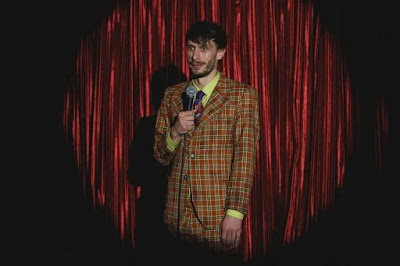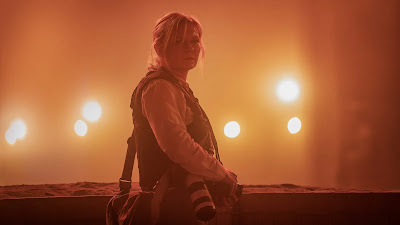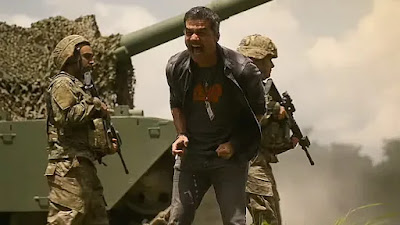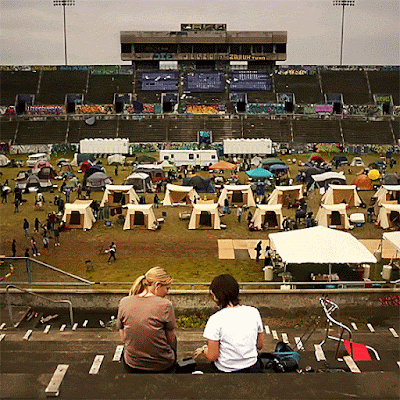E não se esqueçam de
curtir e seguir o blog nas redes sociais:
(And don't forget to
like and follow the blog in social medias:)
Facebook:
https://www.facebook.com/NoCinemaComJoaoPedroBlog/
Twitter:
@nocinemacomjp2
Instagram:
@nocinemacomjpblog
YouTube:
https://youtube.com/@nocinemacomjp
“ - Você tiraria
uma foto deste momento, se eu fosse baleada?
- O que você
acha?”
(“ -
Would you photograph that moment, if I got shot?
-
What do you think?”)
Certos
filmes já nascem como obras que dividirão o público em dois
extremos: aqueles que o consideram como uma verdadeira obra-prima, e
aqueles que acham que o mesmo filme é uma bagunça sem sentido.
Mesmo assim, é o suficiente para agregar uma legião de fãs. Como
exemplos recentes, temos “mãe!”, de Darren Aronofsky;
“Babilônia”, de Damien Chazelle; e “Saltburn”, de Emerald
Fennell. O diretor e roteirista britânico Alex Garland pode ser
considerado um expert em realizar este tipo de obra. Após uma
aclamação unânime por sua estreia em “Ex Machina: Instinto
Artificial”, seus dois longas subsequentes, “Aniquilação” e
“Men: Faces do Medo”, tiveram uma reação essencialmente mista
por parte da crítica e do público, deixando alguns impressionados e
outros coçando as cabeças. Em sua quarta empreitada como diretor,
“Guerra Civil”, um dos
lançamentos desta quinta-feira (18) nos cinemas, não temos uma
exceção.
A
proposta do quarto longa de Garland já é o suficiente para afastar
uma parcela específica de seus espectadores em potencial,
apresentando um país dividido, liderado por uma figura claramente
inspirada no ex-presidente Donald Trump, contaminado pelo fácil
acesso às armas de fogo, que possibilitam a criação de facções
rivais. Porém, há uma certa originalidade no gênero específico
dos filmes anti-guerra aqui, já que a trama segue o ponto de vista
de jornalistas, destacando tanto a necessidade da profissão quanto o
potencial sensacionalista de suas produções, em especial quando o
assunto é guerra. O diretor faz um ótimo uso da câmera, do som e
de um quarteto fortíssimo de protagonistas para trazer as mensagens
de “Guerra Civil”
à luz, e mesmo que possa faltar um contexto do que realmente está
acontecendo, Garland e companhia compensam com um enredo
constantemente tenso recheado de imagens chocantes que desafiam o
espectador a desviar o olhar.
(Some
films are already born as works that will divide their audience into
two extremes: those who will consider it as a true masterpiece, and
those who feel the same movie is a garbage dump of nonsense. Even so,
it's enough to gather them a legion of fans. As recent examples, we
have Darren Aronofsky's “mother!”, Damien Chazelle's “Babylon”
and Emerald Fennell's “Saltburn”. British writer-director Alex
Garland can be considered an expert in making this particular kind of
work. After unanimous praise for his debut in “Ex Machina”, his
two subsequent features, “Annihilation” and “Men”, had an
essentially mixed reaction from both critics and audiences, leaving
some impressed and others scratching their heads. In his fourth
endeavor as director, “Civil War”,
one of this week's releases, now playing in theaters, we have no
exception.
The
proposition of Garland's fourth feature is already enough to make a
specific portion of its potential viewers turn their heads,
presenting us with a divided country, led by a figure clearly
inspired by former president Donald Trump, contaminated by easy
access to firearms, which make the creation of rival factions
possible. However, there's a certain originality in the specific
genre of anti-war films here, as the plot follows the point of view
of journalists, highlighting both the necessity of that line of work
and the sensationalist potential of its productions, especially when
it comes to war. The director makes a great use of camera, sound and
a really strong quartet of protagonist to bring the messages of
“Civil War” to
light, and even though it may lack context on what's really going on,
Garland and co. make up for it with a constantly tense story filled
with shocking images that dare the viewer to look away.)
Trama
Ambientado em um futuro próximo, a trama acompanha Lee (Kirsten
Dunst), uma fotojornalista que embarca em uma jornada pelos EUA até
Washington, juntamente com três colegas: Joel (Wagner Moura), um
repórter; Jessie (Cailee Spaeny), uma aspirante a fotógrafa; e
Sammy (Stephen McKinley Henderson), um redator idoso. O grupo parte
com o objetivo de entrevistar o Presidente (Nick Offerman) antes que
as duas facções em guerra tomem a Casa Branca para si, enfrentando
várias ameaças e mudanças pelo caminho.
(Plot
Set
in the near future, the plot follows Lee (Kirsten Dunst), a
photojournalist who embarks on a journey across the United States all
the way to Washington D.C., alongside three colleagues: Joel (Wagner
Moura), a reporter; Jessie (Cailee Spaeny), an aspiring photographer;
and Sammy (Stephen McKinley Henderson), an elderly writer. The group
sets off with the goal of interviewing the President (Nick Offerman)
before the two warring factions take over the White House, facing
several threats and changes along the way.)
Os
dois lados da moeda jornalística
A primeira coisa que chama a atenção em “Guerra Civil”
é o quão atual o roteiro de Garland consegue ser, em duas vertentes
em particular. Primeiro, temos aqui uma abordagem realista de um
cenário de guerra, destacando o horror da situação e o impacto que
ela tem nas pessoas, através de imagens essencialmente chocantes.
Corpos em diferentes estados de decomposição, atos de terrorismo,
pessoas enforcadas em público. O diretor faz questão de mostrar
isto da maneira mais crua possível, causando o máximo de impacto em
seus personagens e nos espectadores. A segunda vertente é o perigo
de uma nação ideologicamente dividida, e esta interpretação é
especialmente relevante para os EUA, onde haverá eleição em 2024.
O realismo e as analogias aos cenários de guerra da atualidade
cooperam para a urgência da trama e para um sentimento coletivo de
pavor, do quão próximo o retrato do filme parece estar da
realidade.
A desolação e imprevisibilidade da guerra levam a trama de Garland
por um caminho extremamente tenso, deixando o espectador roendo as
unhas em antecipação do que está por vir. Aqui, o diretor replica
o tom sério de um dos seus trabalhos mais famosos, o filme de zumbis
“Extermínio”, aplicando a mesma energia aterrorizante e
constantemente surpreendente, embora em um passo mais lento e
meditativo, tomando algumas pausas entre as cenas de ação para
desenvolver seus personagens de uma maneira muito eficaz. Um destaque
fica para a personagem de Cailee Spaeny, que, por sua juventude e
falta de experiência, é o maior veículo para transmitir as
cicatrizes emocionais que a guerra deixa em uma pessoa.
Porém, o maior trunfo de “Guerra Civil”, além de seu
retrato de um cenário realista de um conflito, é a abordagem do
jornalismo de guerra como uma espada de dois gumes. Por um lado, ele
é visto como uma profissão essencial e necessária, que é chave
para conseguir registros e atualizações em primeira mão, correndo
atrás do objetivo de levar a informação ao público. Além disso,
no entanto, o roteiro destaca o potencial sensacionalista de um
conteúdo tão explícito, onde a exposição ao extremo pode levar à
uma indiferença emocional por parte do jornalista, que passa a
perseguir as imagens e situações mais violentas, “glamourizando”
o fazer jornalístico ao invés de humanizá-lo. Essa dualidade é
refletida de forma perfeita no roteiro através da troca de
experiências entre as personagens de Spaeny e Kirsten Dunst, onde a
última, embrutecida por eventos passados, tenta evitar que a
primeira siga o mesmo caminho.
Mesmo que a trama não seja sobre a guerra em si, mas sim o impacto
que ela tem nas pessoas, a falta de contexto sobre o conflito
retratado em “Guerra Civil” ainda é notável. Garland
deixa migalhas de conteúdo espalhadas pelo enredo, que oferecem uma
perspectiva fragmentada do porquê da nação estar dividida. Porém,
não é o suficiente para que o espectador tenha uma visão
abrangente e completa do cenário, deixando as motivações de cada
lado, os componentes de cada facção e as razões por trás das
alianças no escuro. Por exemplo, um dos grupos em luta é composto
de uma parceria entre os estados do Texas, um território amplamente
conservador, e da Califórnia, que segue ideologias completamente
opostas, e nunca nos é explicado o motivo de uma união tão
teoricamente improvável.
(The two sides of the journalistic coin
The first thing that comes to attention in “Civil War” is
how timely Garland's screenplay manages to be, in two particular
lines of thought. Firstly, we have here a realistic approach of a war
scenario, highlighting the horror of the situation and the impact it
has on people, through essentially shocking imagery. Bodies in
different states of decay, acts of terrorism, people hung in public.
The director makes a point in displaying this in the rawest way
possible, causing maximum impact in his characters and viewers.
Secondly, there's a looming sense of danger of an ideologically
divided nation, and this portrayal is especially relevant for the
United States, where 2024 will be an election year. The realism and
the analogies towards real-life war scenarios cooperate for the
plot's urgent tone, as well as a collective sense of dread, of how
close this film seems to be to reality.
The bleakness and unpredictability of war lead Garland's plot
through an extremely tense path, leaving the viewer biting their
nails in anticipation of what's to come. Here, the director
replicates the serious tone of one of his most famous screenwriting
works, the zombie film “28 Days Later”, applying the same
terrifying and constantly surprising energy, although in a slower,
more meditative pace, taking a few breaks inbetween the action scenes
to develop his characters in a most effective way. A clear standout
here is Cailee Spaeny's character, who, due to her age and lack of
experience, is the biggest anchor to convey the emotional scars that
war can leave on someone.
However, the greatest strength in “Civil War”, more so
than its realistic portrayal of a conflict scenario, is its approach
of war journalism as a double-edged sword. On one hand, it is seen as
a necessary, essential line of work, which is key in managing to get
first-hand records and updates, running towards the goal of getting
the information into the public eye. Besides that, on the other hand,
the screenplay highlights the sensationalist potential of such an
explicit content, where extreme exposition can lead to a journalist's
emotional indifference, a state of mind where they begin chasing
after the most violent situations and images, painting the
journalistic line of work in a more “glamourous” light than in a
human one. This duality is perfectly reflected in the script through
the exchange of experience between Spaeny and Kirsten Dunst's
character, where the latter, hardened by past events, tries to stop
the former from following the same path.
Even though the plot isn't about the war itself, but the impact it
leaves on people, the lack of context on the portrayed conflict in
“Civil War” is still very visible. Garland leaves mere
crumbs of content throughout the story, which offer a fragmented
perspective on why the nation is divided. However, it's not enough
for the viewer to have a wide, complete view of the battleground,
leaving each side's motivations, the components of each faction and
the reasons behind their alliances in the dark. For example, one of
the fighting groups is composed by a partnership between the states
of Texas, a widely conservative territory, and California, which
follows completely opposite ideologies, and we never have an
explanation for such a theoretically unlikely union.)
Jornalistas
em diferentes estágios
Uma coisa muito interessante sobre os personagens jornalistas de
“Guerra Civil” é como eles se encontram em diferentes
estágios da profissão, e como que, ao longo da trama, cada um passa
para uma fase diferente. De baixo para cima, temos a Cailee Spaeny,
que, após uma performance reveladora em “Priscilla”, continua
sua ascensão ao estrelato de maneira muito eficaz aqui. É através
dela que o espectador enxerga os eventos chocantes do enredo e é
fascinante acompanhar o desempenho da atriz ao retratar a evolução
(ou seria involução?) da perspectiva da sua personagem em relação
à guerra. Mais acima, temos o Wagner Moura, que faz um ótimo
trabalho como um repórter que anseia por estar em meio ao conflito
em si, e a surpresa nas expressões do ator quando os eventos no
decorrer da trama o acertam em cheio é crível, humana e
emocionante.
Em
um estágio superior, temos a Kirsten Dunst, em uma de suas melhores
performances recentes, como uma fotojornalista veterana claramente
traumatizada pelas inúmeras guerras que registrou, resultando em uma
personagem constantemente fechada, tensa e séria. A dinâmica entre
ela e Spaeny é a força motriz do enredo, e os momentos
compartilhados pelas duas emprestam uma certa leveza ao tom sombrio
do roteiro, sendo essenciais para o desenvolvimento de ambas as
personagens, com Dunst servindo como uma figura materna para Spaeny;
e esta evoluindo como uma jornalista cada vez mais amadurecida. Na
última fase, temos o Stephen McKinley Henderson, que interpreta o
mentor de Dunst e Moura, alguém completamente aterrorizado pelo
conflito, evitando ao máximo o contato próximo com o mesmo, sendo
um dos personagens mais sensatos da trama.
Porém, há um ator em “Guerra Civil” que aparece em
menos de 15 minutos de tela, e consegue roubar o filme inteiro para
si através de uma única cena, e este ator é o Jesse Plemons. Após
atuações mais carismáticas em “Amor e Morte” e “Assassinos
da Lua das Flores”, Plemons retorna ao sadismo e à frieza de seu
papel mais famoso, o Todd de “Breaking Bad”, mesmo que de forma
breve. Há uma aura tão ameaçadora ao redor de seu personagem, um
membro de uma milícia supremacista xenofóbica, que ela acaba
perdurando pelo restante da trama, com a sequência protagonizada por
Plemons encapsulando a tensão, o horror e o pavor de estar em meio à
uma zona de guerra.
(Journalists in different stages
Something really interesting about the journalist characters in
“Civil War” is how they find themselves in different
stages of the profession, and how they manage to pass on to a
different stage, throughout the plot. Starting from the bottom, we
have Cailee Spaeny, who, following a revealing performance in
“Priscilla”, continues her rise to stardom in a very effective
way here. The viewer sees the story's shocking events through her
eyes, and it's fascinating to follow the actress's way of conveying
her character's evolution (or is it devolution?) of perspective
towards war. One step above, we have Wagner Moura, who does a great
job as a reporter who longs to be in the middle of the conflict
itself, and the surprise in the actor's expressions when the
narrative's subsequent events hit him straight on is believable,
human and emotional.
On an upper stage, we have Kirsten Dunst, in one of her best recent
performances, as a veteran photojournalist who's clearly traumatized
by the countless wars she has witnessed, resulting in a constantly
shut, tense and serious character. The dynamic between her and Spaeny
is the plot's conductive force, and the moments they share lend some
levity to the script's dark tone, being essential to the development
of both their characters, with Dunst as a mother figure to Spaeny;
and the latter evolving as a gradually more mature journalist. On the
last stage, we have Stephen McKinley Henderson, who plays the mentor
of Dunst and Moura, and is completely terrified by the conflict,
doing his best to avoid close contact with it, being one of the most
reasonable characters in the story.
However,
there is one actor in “Civil War”
who shows up in less than 15 minutes of screentime and manages to
steal the entire film for himself through one single scene, and that
is Jesse Plemons. After more charismatic performances in “Love and
Death” and “Killers of the Flower Moon”, Plemons returns to the
cold and sadistic nature of his most famous role, Todd from “Breaking
Bad”, even if for a very brief amount of time. There is such a
threatening aura surrounding his character, a member of a
supremacist, xenophobic militia, that it's still very much present
throughout the remainder of the plot, with the sequence featuring
Plemons encapsulating the tension, the horror and the dread of being
in the middle of a warzone.)
Imagem
e som imersivos
Tecnicamente, “Guerra Civil” é um espetáculo de imagem
e som que implora para ser visto na maior tela possível. É
impressionante como o maior orçamento da história da A24,
distribuidora do filme nos EUA, foi investido para retratar algo
estritamente focado na realidade. Não há nenhum estilo na câmera
de Rob Hardy, colaborador frequente do diretor, e isto é 100%
proposital. As imagens que ele nos mostra são cruas, impactantes e
aterrorizantes, de tão reais que parecem ser. Em partes, o visual me
lembrou de “Laranja Mecânica”, no sentido de retratar um futuro
próximo sem especificar o quão próximo ele está dos tempos
atuais, fazendo tudo ficar ainda mais sinistro. Em colaboração com
a urgência do roteiro, a fotografia de Hardy chama a atenção para
o horror da guerra, quase como um aviso, e isso é simplesmente
incrível.
Outro
destaque fica com a montagem, que também consegue reter o realismo
no retrato do conflito, estendendo certas cenas pelo tempo que for
necessário, e consequentemente aumentando a tensão e a preocupação
do espectador com os personagens. A montagem é especialmente eficaz
nas sequências onde as personagens de Dunst e Spaeny fotografam os
cenários de guerra, com cortes bem rápidos mostrando o resultado
final de suas produções, de forma bem nítida e impactante. O
trabalho fotográfico aqui, simulando o fotojornalismo de guerra,
possui uma beleza melancólica e sombria de tirar o fôlego. Hardy
consegue capturar momentos cruciais na trama e a montagem, em
contrapartida, consegue eternizá-los na tela e na mente dos
espectadores.
Por fim, o design de som e a trilha sonora são essenciais na
construção de tensão ao longo de “Guerra Civil”. É
incrível o que Garland consegue fazer com o silêncio em um cenário
tão imprevisível, enchendo o espectador com a ansiedade de que algo
muito grave está prestes a acontecer com estes personagens. E quando
o som se faz presente, ele ecoa com muita força. Por exemplo, quando
há o barulho de um tiro em uma situação silenciosa, o eco do tiro
cria um zumbido enervante na mente do espectador. De fato, as
melhores cenas do longa são completamente isentas do uso de trilha
sonora, que, por sua vez, é reservada para momentos específicos,
focados nos aspectos emocionais dos personagens, me lembrando muito
do trabalho de Gustavo Santaolalla em “The Last of Us”.
(Immersive imagery and sound
Technically, “Civil War” is a spectacle of image and
sound that begs to be experienced on the largest screen you can find.
It's impressive how the biggest budget in the history of distributor
A24 was invested to portray something strictly focused on reality.
There is no style in Rob Hardy's cinematography, in his fourth
collaboration with the director, and that's 100% on purpose. The
images he shows us are raw, impactful and terrifying, because of how
real they seem to be. Partly, the visuals reminded me of “A
Clockwork Orange”, in the way of displaying a near future and not
specifying how near that future is from present time, making the
whole thing all the more sinister. Working in tandem with the
screenplay's urgency, Hardy's cinematography highlights the horror of
war, almost like a warning, and that's simply amazing.
Another highlight stays with the editing, which also retains the
realism in the conflict's portrayal, extending some scenes for as
long as it's necessary, which consequently ratchets up the tension
and the viewer's concern towards the characters. The editing is
especially effective in the sequences where Dunst and Spaeny's
characters are photographing the warzones, with pretty swift cuts
showing the final results of their productions, in a very clear,
impactful way. The photography work here, simulating war
photojournalism, possesses a breathtaking melancholic and dark
beauty. Hardy manages to capture crucial moments in the plot and the
editing, on the other hand, makes these moments eternal onscreen and
inside the viewer's mind.
At last, the sound design and soundtrack are essential when it comes
to building up tension in “Civil War”. What Garland
manages to do with silence in such an unpredictable scenario is
nothing short of incredible, filling up the viewer with the anxiety
that something really bad is about to happen to these characters. And
when sound does mark its presence, it echoes with amazing force. For
example, when there's a gunshot sound in a quiet situation, the echo
of the gunshot creates an unnerving ringing in the viewer's mind.
Indeed, the feature's best scenes are completely free of any use of
score or soundtrack, which, in turn, are reserved for specific
moments, focused on the emotional aspects of the characters,
reminding me a lot of Gustavo Santaolalla's work in “The Last of
Us”.)

Resumindo, “Guerra Civil” peca ao não revelar muito
sobre o contexto do conflito retratado, mas o roteirista e diretor
Alex Garland compensa com um roteiro essencialmente atual e urgente
que mostra o horror da guerra e os dois lados da profissão
jornalística neste cenário, um quarteto fortíssimo de
protagonistas e um uso magistral e realista de seus aspectos
técnicos, resultando em uma obra tensa do início ao fim.
Nota: 9,5 de 10!!
É isso, pessoal! Espero que tenham gostado! Até a próxima,
João Pedro
(In a nutshell, “Civil War” might not offer a lot of
context on the portrayed conflict, but writer and director Alex
Garland makes up for it with an essentially timely and urgent script
that displays the horrors of war and the two sides of the
journalistic profession in this scenario, a very strong quartet of
protagonists and a masterful and realistic use of its technical
aspects, resulting in a film that's tense from beginning to end.
I give it a 9,5 out of 10!!
That's it, guys! I hope you liked it! See you next time,
João Pedro)


























